
Overview of the Book
Polar Bear, Polar Bear, What Do You Hear? is a charming children’s story written by Bill Martin Jr. and illustrated by Eric Carle. It follows a polar bear and other zoo animals as they explore the sounds they hear, creating a fun and engaging narrative. The book is part of the Brown Bear and Friends series, known for its rhythmic, repetitive text and vibrant collage-style artwork. Each page introduces a new animal, encouraging young readers to predict and imitate the sounds, making it interactive and enjoyable. The story’s simplicity and repetitive structure make it perfect for early learners, while its imaginative elements spark curiosity about wildlife. Available in PDF format, the book is widely accessible for reading and sharing, ideal for classrooms, homeschooling, or family storytime.
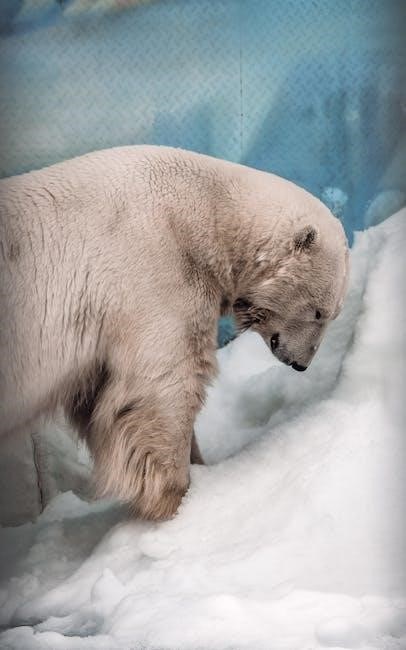
Authors and Illustrators: Bill Martin Jr. and Eric Carle
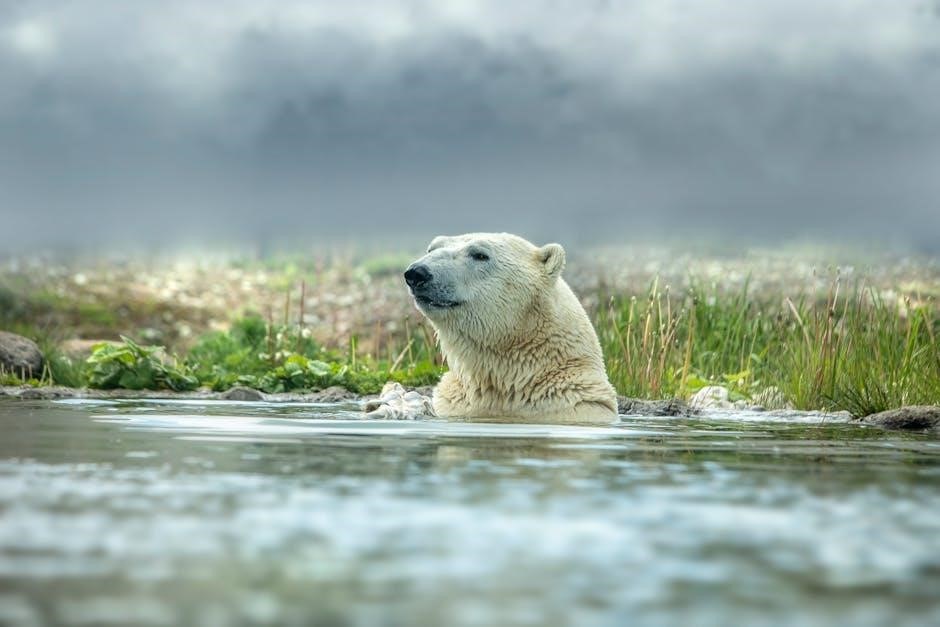
Bill Martin Jr. and Eric Carle are the renowned creators of Polar Bear, Polar Bear, What Do You Hear?. Bill Martin Jr., a beloved children’s author, crafted the rhythmic text that has captivated readers worldwide. His expertise in early literacy and phonological awareness is evident in the book’s repetitive, rhyming structure; Eric Carle, a celebrated illustrator, brought the story to life with his signature collage-style artwork. Carle’s vibrant, textured illustrations have become iconic, enhancing the narrative and engaging young minds visually. Together, they created a timeless classic that has become a staple in children’s literature, blending education with entertainment. Their collaboration continues to inspire both children and educators, making their work a lasting legacy in the world of children’s books.
Part of the Brown Bear and Friends Series
Polar Bear, Polar Bear, What Do You Hear? is a delightful addition to the Brown Bear and Friends series, which includes beloved titles like Brown Bear, Brown Bear, What Do You See? and Panda Bear, Panda Bear, What Do You See?. This series is known for its rhythmic, repetitive text and vibrant illustrations, making it a favorite among children and educators. Each book introduces a new set of animals, sounds, and experiences, fostering a sense of familiarity and curiosity in young readers. The series’ consistent structure and engaging format have made it a cornerstone of early childhood literacy, with Polar Bear, Polar Bear, What Do You Hear? standing out as a fan-favorite for its Arctic wildlife and playful storytelling.
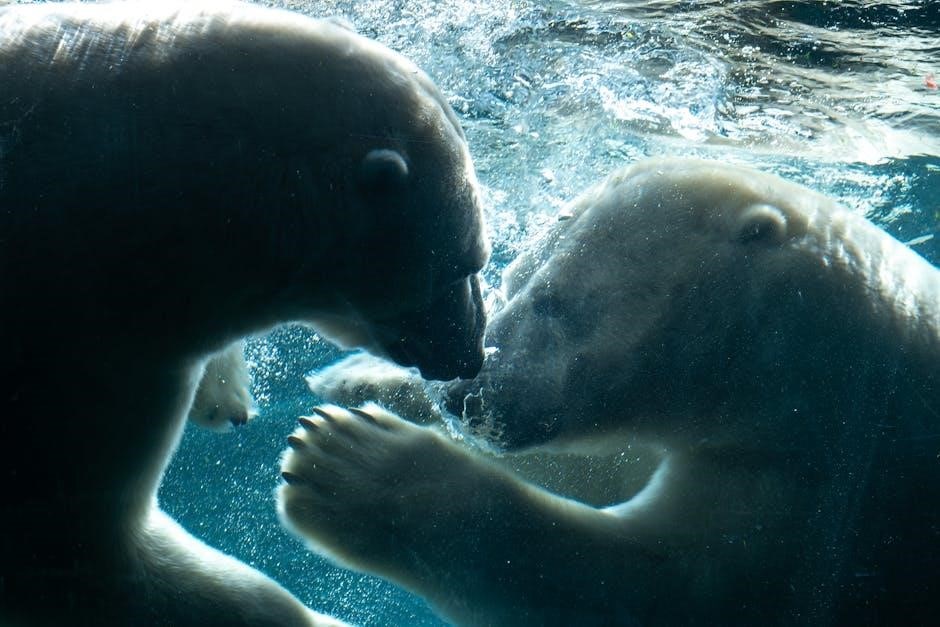
Plot and Structure of the Book
The story features repetitive phrases and a rhythmic structure, building anticipation as each animal asks, “What do you hear?” Introducing various zoo animals and their sounds, it creates a engaging narrative flow that captivates young readers.
Interactive Storytelling and Repetitive Text
Written by Bill Martin Jr. and illustrated by Eric Carle, Polar Bear, Polar Bear, What Do You Hear? captivates children with its rhythmic and repetitive text. Each page follows a predictable pattern, encouraging young readers to participate by predicting and repeating the phrases. This interactive storytelling technique fosters phonological awareness and memory skills, making it an engaging and educational experience. The repetition also helps children develop their language abilities while immersing them in the imaginative world of zoo animals and their unique sounds.
Polar Bear, Polar Bear, What Do You Hear? introduces children to various zoo animals, each accompanied by their distinct sounds. From the roar of a lion to the chirp of a bird, the book uses vivid descriptions to familiarize young readers with the unique vocalizations of each creature. This engaging approach not only educates children about wildlife but also sparks their curiosity about the natural world. The colorful illustrations by Eric Carle further enhance the learning experience, making the book a delightful way for children to discover the fascinating sounds of zoo animals.

Building Anticipation and Curiosity in Readers
Polar Bear, Polar Bear, What Do You Hear? masterfully builds anticipation and curiosity through its engaging narrative structure. Each page introduces a new animal, prompting readers to wonder, “What will it hear next?” The repetitive questioning creates a sense of rhythm, encouraging children to predict and participate actively. As the story unfolds, the suspense grows, keeping young readers eager to discover the next animal and its sound. This interactive approach fosters curiosity and excitement, making the book a delightful experience for children. The vivid illustrations further enhance the sense of adventure, inviting readers to explore the vibrant world of zoo animals. This element of surprise and engagement makes the book a timeless favorite for early learners.
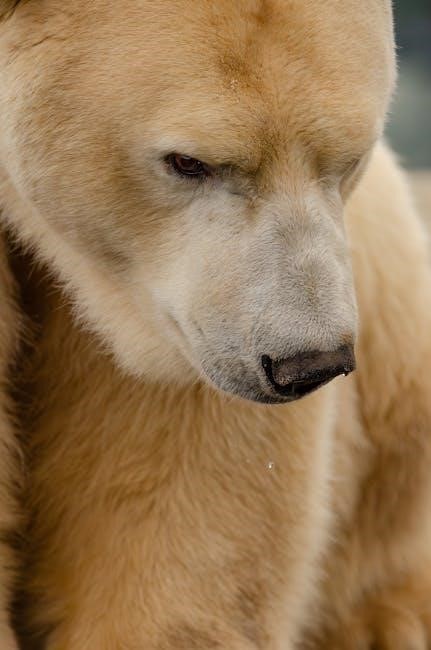
Educational Value of the Book
Polar Bear, Polar Bear, What Do You Hear? enhances phonological awareness, introduces wildlife, and fosters creativity. Its repetitive text and animal sounds promote early learning and engagement in young readers.
Phonological Awareness and Rhyming
Polar Bear, Polar Bear, What Do You Hear? excels in fostering phonological awareness through its rhythmic, repetitive text and playful rhymes. The book’s structure, with predictable patterns and animal sounds, helps children recognize and mimic sounds, a foundational skill for reading. The rhyming words, such as “hear” and “fear,” introduce young learners to word families and alliteration. This engaging approach makes learning fun and interactive, encouraging children to participate aloud. The PDF version retains these phonological elements, ensuring that digital readers benefit equally from the book’s educational design. By focusing on sound recognition and repetition, the story supports early literacy development in an enjoyable and accessible way.
Introducing Children to Wildlife and Their Characteristics
Polar Bear, Polar Bear, What Do You Hear? serves as an engaging tool for introducing children to various zoo animals and their unique traits. The story features a diverse range of wildlife, from polar bears and lions to frogs and birds, each accompanied by their distinctive sounds. This interactive approach helps young readers associate specific animals with their characteristic vocalizations, fostering an early understanding of wildlife diversity. The vibrant illustrations by Eric Carle further enhance the learning experience, visually depicting each animal’s appearance and behavior. By exploring these creatures in a fun and relatable way, the book sparks curiosity and encourages children to learn more about the natural world. Its availability in PDF format ensures accessibility, allowing kids to discover wildlife from the comfort of home or classroom.
Encouraging Creativity and Participation
Polar Bear, Polar Bear, What Do You Hear? is designed to encourage creativity and active participation in young readers; The repetitive text and rhythmic structure invite children to join in, predicting and mimicking the sounds of the animals. This interactive element fosters a sense of engagement, turning reading into a shared experience. The story’s pattern also allows kids to express their creativity by imagining and creating their own animal sounds or stories. Additionally, the book’s availability in PDF format makes it easy to access and share, enabling parents and educators to incorporate it into interactive reading sessions or crafts. This hands-on approach helps children develop their communication skills while fostering a love for storytelling and imaginative play.
Availability of the Book in PDF Format
Free PDF Downloads and Flipbooks
Platforms for Accessing the PDF Version
How to Download and Share the PDF
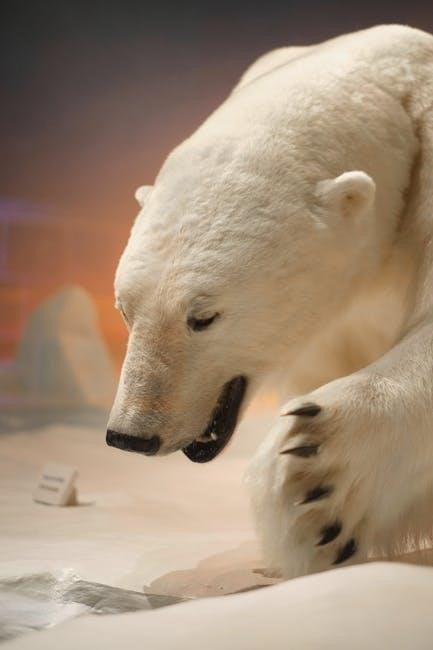
Impact and Popularity of the Book
Polar Bear, Polar Bear, What Do You Hear? is a beloved book by Bill Martin Jr. and Eric Carle, cherished by children and educators. Widely used in classrooms, it remains a timeless children’s literature classic.
Reception Among Children and Educators
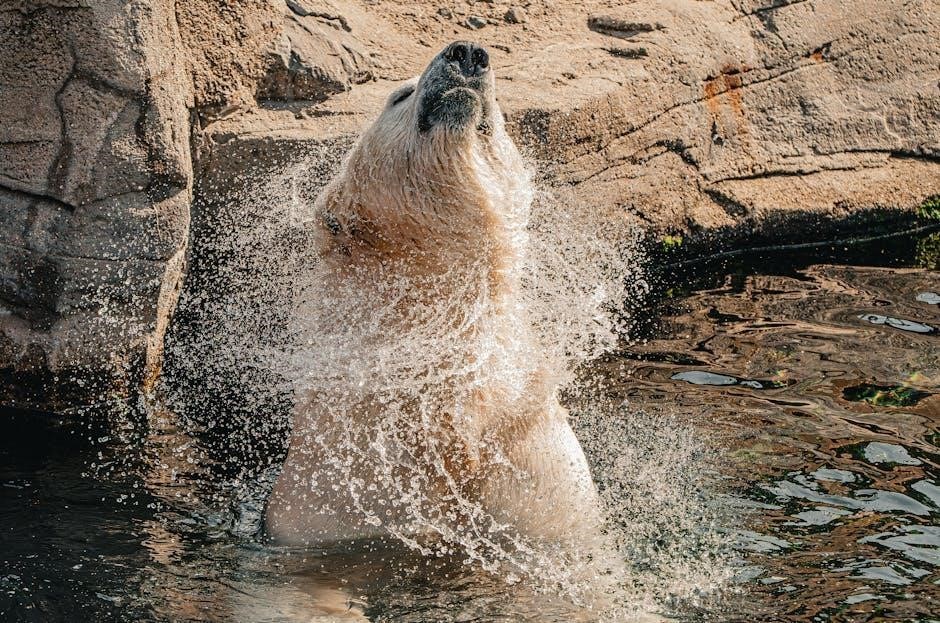
Polar Bear, Polar Bear, What Do You Hear? has delighted children and educators alike with its engaging rhythm and vivid illustrations. Its repetitive text and animal sounds make it a favorite in classrooms, fostering phonological awareness and active participation. Teachers praise its ability to captivate young learners, while children enjoy the predictable structure and imaginative storytelling. The book’s popularity extends beyond schools, with families embracing it as a bedtime staple. Its availability in PDF format has further boosted its accessibility, allowing educators to integrate it into lesson plans and reading activities. This beloved story continues to inspire creativity and a love for reading in children worldwide.
Use in Classrooms and Homeschooling
Cultural and Educational Significance
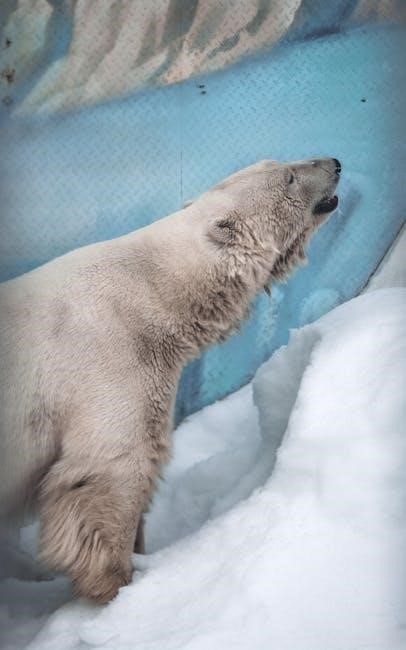
Polar Bear, Polar Bear, What Do You Hear? holds a special place in children’s literature, blending cultural richness with educational value. The book introduces young readers to diverse zoo animals, fostering curiosity about wildlife and their unique characteristics. Its rhythmic text and vibrant illustrations create a universal appeal, making it accessible across cultures. Educators praise its ability to promote phonological awareness, a foundational skill for reading. The book’s interactive nature encourages shared reading experiences, strengthening language development and creativity. Its availability in PDF format ensures global accessibility, making it a valuable tool for educators and families worldwide. This beloved story not only entertains but also educates, leaving a lasting impact on early childhood learning and cultural appreciation.
Additional Resources and Activities
Discover free printable templates, crafts, and teaching guides to enhance the reading experience. Interactive activities include animal sound games and creative art projects inspired by the story.
Free Printable Templates and Crafts
Teaching Guides and Lesson Plans
Teaching guides and lesson plans for Polar Bear, Polar Bear, What Do You Hear? are widely available online, offering educators creative ways to integrate the book into curricula. These resources include activities such as animal sound matching games, rhyming exercises, and wildlife-themed crafts. Lesson plans often focus on phonological awareness, encouraging children to recognize and replicate sounds, while also introducing them to diverse zoo animals. Many guides incorporate the book’s repetitive text to aid in early reading skills and comprehension. Platforms like Teachers Pay Teachers and educational blogs provide downloadable materials, making it easy for teachers to prepare engaging classroom activities. These resources enhance the book’s educational value, transforming it into a comprehensive learning tool for young students.
Reading Companion Activities for Kids
Engaging reading companion activities for Polar Bear, Polar Bear, What Do You Hear? include sound-based games, animal mask crafts, and sequencing exercises. Children can mimic animal noises, enhancing phonological awareness and creativity. Printable templates allow kids to create their own story extensions, fostering imaginative storytelling. Activities like “What Do You Hear?” encourage active listening and prediction skills. Parents and educators can use these resources to make reading interactive and fun, helping children connect with the story on a deeper level. These activities are designed to complement the book’s rhythmic text and vibrant illustrations, making reading a dynamic and enjoyable experience for young learners.
Polar Bear, Polar Bear, What Do You Hear? remains a timeless, beloved tale, inspiring curiosity and creativity in children. Its legacy as a cultural and educational treasure endures, connecting young readers with wildlife and fostering a love for storytelling and learning.
The Legacy of “Polar Bear, Polar Bear, What Do You Hear?”
Polar Bear, Polar Bear, What Do You Hear? has left an indelible mark on children’s literature. Its engaging rhythm and Eric Carle’s iconic illustrations have made it a favorite for generations. The book’s ability to blend storytelling with educational elements has solidified its place in classrooms and homes worldwide. Its availability in PDF format has further expanded its reach, allowing digital access to its timeless charm. The story’s universal appeal lies in its simplicity and interactivity, making it a cherished tool for early learning and a testament to the power of creative storytelling.
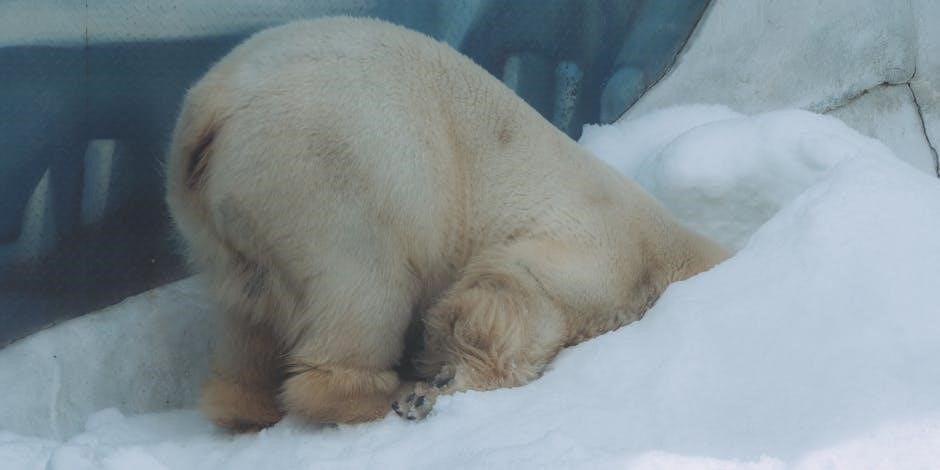
Final Thoughts on the Book’s Importance
Polar Bear, Polar Bear, What Do You Hear? remains a vital resource in early childhood education. Its engaging narrative and repetitive structure foster phonological awareness and language development, while the vibrant illustrations captivate young minds. The book’s ability to introduce diverse wildlife and their sounds encourages curiosity about nature. Available in PDF format, it offers convenience for educators and parents, ensuring accessibility worldwide. As a cultural and educational treasure, it continues to inspire creativity and learning, leaving a lasting impact on children’s literacy and appreciation for wildlife. Its enduring popularity underscores its significance in fostering a love for reading and exploration in young learners.




